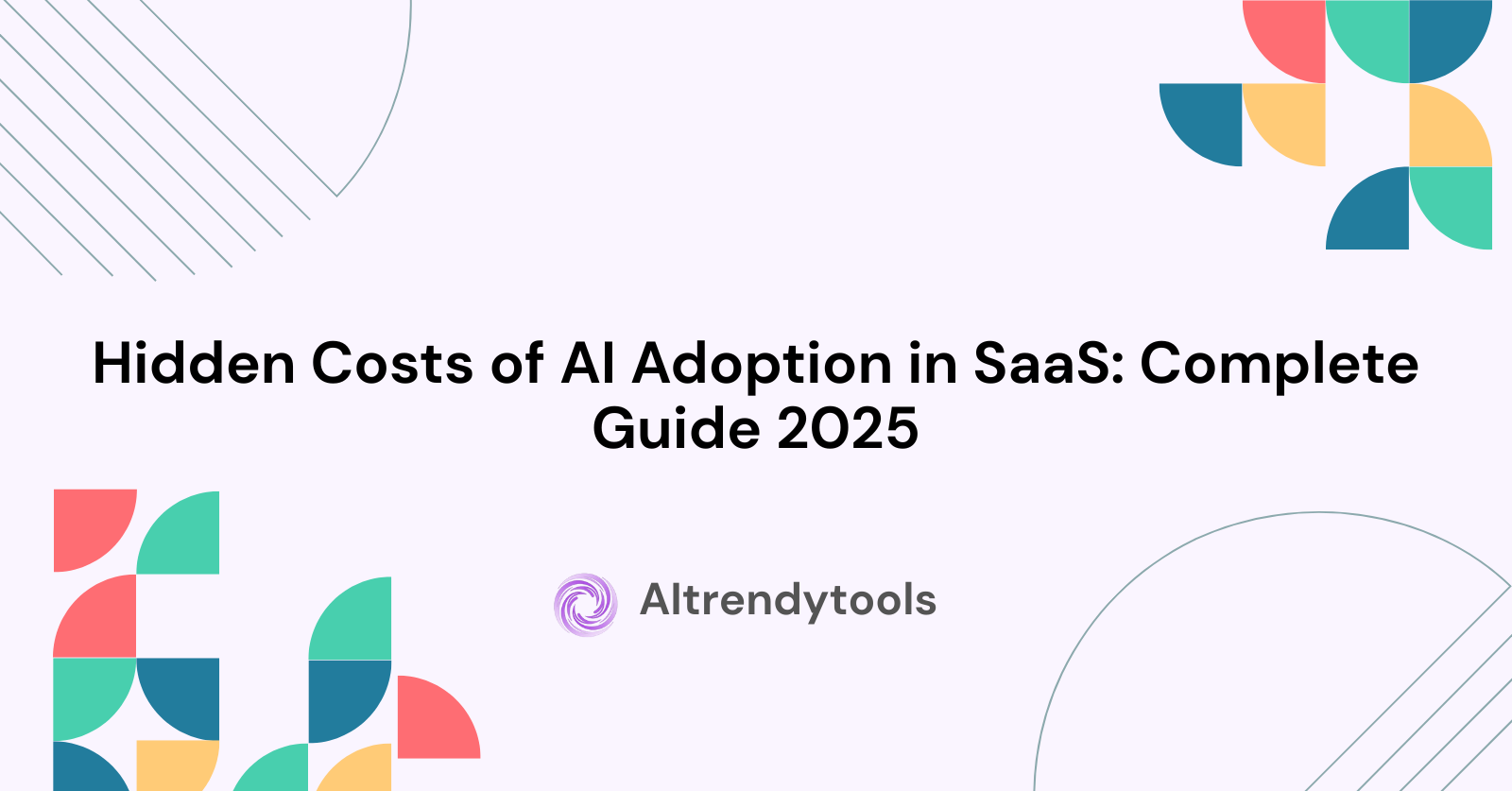🔥 AITrendytools: The Fastest-Growing AI Platform |
Write for usHidden Costs of AI Adoption in SaaS: Complete Guide 2025
Discover the hidden costs of AI adoption in SaaS—from infrastructure to talent. Learn proven strategies to avoid budget overruns and maximize ROI.
Oct 6, 2025
AI adoption promises to revolutionize SaaS businesses with automation, intelligence, and competitive advantages. The excitement surrounding artificial intelligence often overshadows a critical reality: implementation comes with substantial hidden costs that can drain budgets faster than anticipated. Organizations spending an average of $400,000 on AI-native applications face a 75% year-over-year increase in expenses. The true financial impact extends far beyond initial purchase prices or subscription fees.
Understanding these concealed expenses helps businesses make informed decisions about AI integration. Many companies discover unexpected bills months after deployment when cloud costs spiral out of control. Infrastructure requirements, talent acquisition, data management, and ongoing maintenance create financial obligations that continue long after initial implementation. Smart planning prevents budget overruns while maximizing return on investment.
Infrastructure Costs and Cloud Computing Expenses
Cloud infrastructure represents one of the largest hidden expenses in AI adoption. GPU instances cost 15 times more than standard CPU instances on major platforms. Training a single large language model requires millions of dollars in computing power. Organizations often underestimate these expenses during planning phases.
Real-time inference services consume resources continuously rather than during discrete training sessions. A model serving 1,000 predictions per day may cost $50, but scaling to 100,000 predictions doesn't simply multiply that number by 100. Bottlenecks in compute, memory, and data transfer trigger higher-tier resource provisioning. The actual cost often exceeds initial projections by 200-300%.
Storage expenses accumulate rapidly as AI systems generate and process massive datasets. Training data, model versions, logs, and output files all require storage space. Cross-region data transfers add another layer of costs that many teams overlook. These charges emerge gradually, making them difficult to track until monthly invoices arrive.
Idle resource hours represent pure waste in AI infrastructure. Compute instances provisioned for peak loads sit unused during off-peak periods. Organizations pay for capacity they don't utilize because demand fluctuates unpredictably. Monitoring reveals that idle time often exceeds 20% of total compute hours. This inefficiency becomes more expensive as teams and workloads scale.
Data Preparation and Management Expenses
High-quality training data forms the foundation of effective AI systems. Acquiring, cleaning, and labeling data consumes significant resources before any model training begins. Companies without existing structured datasets face particularly steep expenses. Purchasing data from third parties adds thousands or millions to project budgets depending on volume and specificity requirements.
Data labeling costs pile up quickly when human annotation is required. Specialized expertise commands premium rates, particularly in regulated industries like healthcare or finance. A single dataset might need thousands of hours of expert review. Some projects spend more on data preparation than on actual model development.
ETL pipelines for data transformation create ongoing operational costs. Extract, transform, and load processes must run continuously to keep AI systems fed with current information. These workflows consume computing resources and require monitoring. Performance degradation in ETL processes silently increases expenses over time.
Compliance requirements add another dimension to data management costs. GDPR, CCPA, and industry-specific regulations demand robust security measures. Data anonymization, encryption, and audit trails all require investment. Healthcare providers implementing AI face particularly stringent requirements that increase costs substantially. Legal consultations and compliance audits become recurring expenses rather than one-time investments.
Storage infrastructure for AI workloads differs from standard business data needs. High-performance storage systems with fast read/write capabilities cost significantly more than basic options. As datasets grow, storage expenses compound. Companies often discover they need to migrate to more expensive storage tiers as AI applications scale.
Talent Acquisition and Training Costs
AI specialists command some of the highest salaries in technology. Data scientists, machine learning engineers, and AI researchers earn premium compensation. Organizations compete for limited talent pools, driving wages even higher. A single experienced AI engineer can cost $150,000-300,000 annually in salary alone.
Retaining AI talent requires ongoing investment beyond base compensation. Professional development, conference attendance, and cutting-edge tools factor into total employment costs. Top performers expect access to the latest technologies and opportunities for skill advancement. Companies that skimp on these investments face higher turnover rates.
Training existing staff to work with AI systems represents another significant expense. Teams need to understand how to integrate AI outputs into workflows. Customer support personnel require training on AI-assisted tools. Sales teams must learn to explain AI capabilities to prospects. These educational initiatives consume time and budget across the organization.
External consultants fill gaps when internal expertise proves insufficient. Consulting fees for AI specialists reach $200-500 per hour or more. Projects requiring months of consulting engagement accumulate costs rapidly. While consultants accelerate implementation, their expenses often exceed initial budgets.
The learning curve for AI adoption creates productivity dips during transition periods. Staff spend time adapting to new systems rather than performing regular duties. This opportunity cost doesn't appear on invoices but impacts business operations. Organizations must account for reduced output during implementation phases.
Model Development and Training Expenses
Custom model development requires substantial computational resources over extended periods. Training runs can take weeks or months, consuming GPU hours continuously. A single training session for a large model might cost $50,000-500,000 depending on complexity. Failed experiments add to expenses without delivering value.
Hyperparameter tuning demands multiple training iterations to optimize performance. Teams run dozens of experiments to find ideal configurations. Each iteration consumes computing power and time. The cumulative cost of optimization often doubles or triples initial training estimates.
Model retraining creates recurring expenses that many organizations overlook. AI systems require updates to maintain accuracy as data patterns change. Retraining schedules vary from weekly to quarterly depending on application requirements. Each cycle consumes similar resources to initial training. These ongoing costs continue throughout the AI system's lifetime.
Version control and experiment tracking for AI models require specialized infrastructure. MLOps platforms add subscription costs to technology stacks. Storage for multiple model versions and associated artifacts accumulates over time. Organizations need robust systems to manage the complexity of AI development lifecycles.
Failed experiments and abandoned projects represent sunk costs in AI development. Not every model achieves acceptable performance levels. Teams may spend months developing solutions that ultimately don't meet business requirements. This risk inherent in AI projects makes budgeting challenging. Contingency funds become necessary to absorb unsuccessful attempts.
Integration and Deployment Challenges
Connecting AI systems to existing business applications creates technical complexity. Legacy software often lacks APIs or modern integration capabilities. Custom middleware development becomes necessary to bridge gaps between old and new systems. These integration projects consume developer time and extend implementation timelines.
Testing and validation before production deployment require dedicated resources. AI systems need extensive testing across various scenarios to ensure reliability. Quality assurance teams must verify outputs meet accuracy standards. This validation process takes longer than traditional software testing because AI behavior can be unpredictable.
Containerization and orchestration infrastructure support AI deployment at scale. Kubernetes clusters, Docker containers, and related technologies require setup and maintenance. Organizations without existing container infrastructure face additional costs establishing these foundations. Operational expertise for these platforms commands premium salaries.
API gateway and management tools enable secure access to AI capabilities. Rate limiting, authentication, and monitoring all require infrastructure investment. Third-party API management platforms charge based on usage volume. As AI adoption grows, these costs scale proportionally.
Rollback capabilities and disaster recovery planning add safety nets that increase costs. Organizations need procedures to revert to previous system states if AI deployments fail. Maintaining parallel systems during transition periods doubles infrastructure expenses temporarily. This redundancy ensures business continuity but strains budgets.
Ongoing Maintenance and Operations
Continuous monitoring of AI systems requires dedicated personnel and tools. Performance metrics, accuracy tracking, and error detection need constant attention. Monitoring platforms charge subscription fees based on data volume and retention periods. Alert fatigue from false positives creates additional operational burden.
Model drift detection and correction demand regular attention. AI performance degrades as real-world data diverges from training datasets. Organizations must establish processes to identify and address drift. Automated monitoring reduces manual effort but introduces tool costs. Some businesses assign full-time staff to model maintenance duties.
Security patching and updates for AI infrastructure create ongoing work. Vulnerabilities in AI frameworks, libraries, and dependencies require timely remediation. Staying current with security updates demands vigilance. Breaches resulting from unpatched systems carry enormous financial and reputational consequences.
Performance optimization never truly ends for production AI systems. Traffic patterns change, user behavior evolves, and business requirements shift. Continuous tuning keeps systems operating efficiently. This optimization work consumes engineering resources indefinitely. Organizations must budget for perpetual improvement rather than treating deployment as a final milestone.
Customer support costs increase when AI systems behave unexpectedly. Users encounter edge cases that training data didn't cover. Support teams field questions about AI recommendations or outputs. Training support staff on AI capabilities becomes necessary. These ongoing support needs persist throughout the AI system's operational life.
Licensing and Subscription Fees
Third-party AI services operate on usage-based pricing models that create unpredictable expenses. Per-token charges for language models accumulate based on actual consumption. A viral use case can crater profit margins overnight. Organizations struggle to forecast costs when usage fluctuates dramatically.
SaaS platforms increasingly bundle AI features at premium price tiers. Vendors charge 50-200% more for AI-enabled versions of existing products. These premiums apply regardless of how much customers actually use AI capabilities. Businesses pay elevated subscription fees even when AI features provide minimal value.
Enterprise AI licenses often include minimum commitments that force advance payments. Organizations commit to spending thresholds before understanding actual usage patterns. These agreements lock companies into long-term financial obligations. Negotiating contract terms becomes critical to managing costs effectively.
API rate limits force purchases of higher-tier plans to meet business needs. Free or low-cost tiers quickly become insufficient as usage grows. Tiered pricing structures create sudden cost jumps when crossing usage thresholds. Planning for these transitions helps avoid budget surprises.
Multiple AI tools across the organization create shadow IT expenses. Departments purchase AI services independently without central oversight. These decentralized procurements result in redundant subscriptions and wasted spending. Centralized governance reveals that over one-third of SaaS costs escape IT visibility.
Compliance and Regulatory Costs
Legal reviews of AI implementations require specialized expertise in emerging regulations. Laws governing AI use vary by jurisdiction and industry. Attorneys familiar with AI compliance command premium fees. Organizations operating across multiple regions face particularly complex compliance landscapes.
Algorithmic bias testing and fairness assessments add quality assurance expenses. AI systems must perform equitably across demographic groups. Third-party audits verify compliance with fairness standards. These assessments require statistical expertise and specialized tools. Remediation work follows when bias is detected.
Documentation requirements for regulated industries create administrative burden. Healthcare, finance, and government applications need extensive records of AI decision-making processes. Audit trails must capture data sources, model versions, and output explanations. Maintaining this documentation consumes resources continuously.
Privacy impact assessments evaluate how AI systems handle personal information. GDPR and CCPA mandate these evaluations for certain applications. External consultants often conduct assessments to ensure objectivity. The process identifies potential privacy risks requiring mitigation.
Certification processes for AI systems in regulated industries add time and expense. Medical device approval, financial services compliance, and government contracting all impose strict requirements. Testing, documentation, and review cycles extend implementation timelines. These delays increase overall project costs through extended development periods.
Change Management and Organizational Impact
Employee resistance to AI adoption creates cultural challenges with financial implications. Workers fear job displacement or struggle with new workflows. Change management programs help smooth transitions but require investment. Communication campaigns, training sessions, and leadership alignment all consume resources.
Process redesign around AI capabilities demands business analysis expertise. Existing workflows must adapt to incorporate AI outputs. This redesign work involves cross-functional collaboration and multiple iterations. Organizations often underestimate the effort required to integrate AI into daily operations.
Productivity losses during transition periods impact business performance. Teams work less efficiently while learning new systems. Customer service may suffer during adjustment phases. These temporary setbacks carry opportunity costs that don't appear on balance sheets but affect business results.
Organizational restructuring sometimes follows AI implementation. New roles emerge while others become redundant. Severance costs, recruitment expenses, and organizational design consulting all factor into transformation expenses. The human side of AI adoption proves more complex than technology challenges.
Executive sponsorship and governance structures require leadership time investment. Steering committees, status reviews, and strategic alignment meetings fill calendars. While necessary for success, this leadership engagement represents significant opportunity cost. Senior executives' time carries high implicit value.
Risk and Failure Costs
Failed AI projects represent complete loss of invested resources. Industry statistics show that 80-90% of AI initiatives never reach production. Organizations pour resources into projects that deliver no business value. Sunk costs from failed experiments can easily reach hundreds of thousands of dollars.
Reputational damage from AI mistakes carries long-term consequences. Biased algorithms, privacy breaches, or inaccurate predictions harm brand perception. Rebuilding trust requires marketing investment and time. Some organizations never fully recover from high-profile AI failures.
Legal liability for AI-related incidents creates potential financial exposure. Discriminatory outcomes, safety failures, or privacy violations trigger lawsuits. Legal defense costs mount quickly even when organizations ultimately prevail. Insurance premiums may increase for companies deploying AI in sensitive applications.
Opportunity costs of pursuing AI versus alternative investments deserve consideration. Resources allocated to AI cannot fund other strategic initiatives. Organizations must evaluate whether AI delivers better returns than competing priorities. This comparison rarely receives adequate attention during planning.
Technical debt accumulation from rushed AI implementations creates future costs. Quick-and-dirty solutions require eventual replacement or major refactoring. Interest on technical debt compounds over time as systems become harder to maintain. Paying down this debt later costs more than doing things properly initially.
Strategies to Control AI Implementation Costs
Start with clearly defined business objectives tied to measurable outcomes. Vague AI initiatives waste resources on solutions seeking problems. Specific goals enable focused development and realistic cost estimation. Return on investment becomes calculable when objectives are quantified.
Pilot projects test AI viability on limited scope before full deployment. Small-scale experiments reveal unforeseen challenges at manageable cost. Lessons learned inform larger implementations. Organizations avoid massive waste by validating approaches incrementally.
Leverage pre-trained models and transfer learning to reduce training costs. Building from existing foundations requires far less computational power than training from scratch. Many use cases don't require custom models developed from ground up. Open-source models provide excellent starting points for experimentation.
Implement robust cost monitoring and governance from project inception. Track expenses across all cost categories continuously. Automated alerts flag unusual spending patterns early. Regular reviews ensure costs remain aligned with budgets. Visibility prevents surprises when invoices arrive.
Right-size infrastructure to match actual needs rather than overprovisioning. Kubernetes autoscaling adjusts resources dynamically based on demand. Spot instances and preemptible VMs offer significant discounts for interruptible workloads. Regular audits identify underutilized resources for downsizing.
Negotiate vendor contracts carefully with clear usage projections and escalation terms. Lock in pricing where possible to avoid surprises. Build flexibility into agreements to adjust as understanding of needs evolves. Professional procurement teams save more than their cost through better negotiations.
Develop internal expertise rather than relying exclusively on consultants. While external help accelerates initial implementation, building internal capabilities reduces long-term dependence. Train existing staff on AI concepts and tools. This investment pays dividends across multiple projects.
Budget Planning Best Practices
Create comprehensive cost models covering all expense categories. Infrastructure, talent, data, maintenance, and indirect costs all deserve explicit line items. Detailed budgets reveal true total cost of ownership. This transparency enables realistic financial planning.
Build contingency reserves of 30-50% above baseline estimates. AI projects consistently exceed initial projections. Unexpected challenges arise during implementation. Adequate reserves prevent mid-project funding crises that derail initiatives.
Phase investments to align with value delivery milestones. Front-loading all expenses before demonstrating results increases risk. Staged funding ties continued investment to proven progress. This approach protects organizations from runaway spending on unproductive efforts.
Track return on investment metrics from early stages through full deployment. Establish baseline performance before AI implementation. Measure improvements continuously to justify continued investment. Clear ROI visibility builds stakeholder support for ongoing funding.
Regular financial reviews catch cost overruns before they become unmanageable. Monthly analysis of actual versus budgeted spending reveals trends. Course corrections become possible when problems surface early. This discipline prevents small issues from mushrooming into major budget failures.
Selecting Cost-Effective AI Solutions
Evaluate whether custom development is truly necessary for your use case. Pre-built solutions from established vendors cost less than ground-up development. Many business problems have existing AI products that adequately address needs. Custom development should be last resort rather than default choice.
Compare total cost of ownership across different deployment models. Cloud-based solutions minimize upfront investment but create ongoing expenses. On-premises deployments require capital expenditure but offer predictable costs. Hybrid approaches balance these considerations. The optimal choice depends on specific circumstances.
Assess vendor financial stability and long-term viability before committing. AI startups offer cutting-edge capabilities but carry sustainability risk. Established technology giants provide stability but may lag innovation. Balancing these factors protects against vendor failure disrupting operations.
Consider open-source alternatives to reduce licensing costs. Many excellent AI frameworks and models are freely available. Active communities provide support and continuous improvements. Organizations save substantially on licensing while maintaining capability. Some businesses build competitive advantages through open-source mastery.
Prioritize solutions with strong integration capabilities to minimize custom development. APIs, pre-built connectors, and standard data formats reduce implementation complexity. Integration work consumes significant resources in AI projects. Choosing AI products that play well with existing systems delivers enormous savings.
Measuring and Optimizing ROI
Establish clear baseline metrics before AI deployment begins. Measure current performance across relevant dimensions. This foundation enables accurate calculation of improvements attributable to AI. Without baselines, demonstrating value becomes challenging.
Define success criteria that align with business objectives rather than technical metrics. Accuracy scores matter less than business impact. Revenue increase, cost reduction, or customer satisfaction improvements prove value. Technical achievements mean nothing without business results.
Implement attribution models that isolate AI contribution from other factors. Correlation doesn't prove causation in business outcomes. Control groups and statistical analysis clarify true AI impact. This rigor ensures accurate ROI calculations.
Regular ROI reviews assess whether continued investment is justified. Initial results may not predict long-term value. Quarterly analysis reveals trends in AI system performance. Organizations should feel empowered to cut losses on underperforming initiatives.
Optimize resource allocation based on ROI data across multiple AI projects. Some initiatives deliver better returns than others. Shifting investment toward high-performing projects maximizes overall value. This portfolio approach to AI investment improves organizational results.
Common Mistakes to Avoid
Underestimating data requirements leads to expensive delays mid-project. Teams discover they lack sufficient training data after beginning development. Acquiring additional data takes months and strains budgets. Thorough data assessment before project kickoff prevents this costly mistake.
Neglecting change management creates adoption barriers that undermine value. Even excellent AI systems fail when users resist adoption. Change management investments pay for themselves through improved utilization. Treating AI implementation purely as technical challenge guarantees problems.
Skimping on monitoring and governance creates long-term technical debt. Production AI systems require ongoing attention to maintain performance. Organizations that view deployment as the finish line encounter problems later. Sustainable AI requires permanent operational commitment.
Chasing cutting-edge capabilities rather than solving real problems wastes resources. Latest AI breakthroughs sound exciting but may not address business needs. Focusing on genuine pain points delivers better returns than implementing AI for its own sake.
Failing to plan for scale creates expensive rearchitecture work later. Systems designed for pilot scale often can't handle production volumes. Rebuilding infrastructure costs more than designing for scale initially. Thinking several steps ahead prevents painful and expensive transitions.
Future-Proofing Your AI Investment
Build flexible architectures that accommodate evolving AI technologies. Today's cutting-edge approaches become obsolete quickly in fast-moving field. Modular designs enable swapping components without complete rebuilds. This flexibility reduces long-term costs as technology advances.
Maintain vendor diversification to avoid lock-in to specific platforms. Dependency on single provider creates leverage disadvantage. Multi-cloud strategies and open standards provide negotiating power. Some vendor lock-in is inevitable, but minimizing it protects interests.
Invest in foundational capabilities that transcend specific AI techniques. Data infrastructure, MLOps platforms, and organizational expertise remain valuable regardless of algorithmic trends. These foundations support multiple AI initiatives over time. Building core capabilities delivers compounding returns.
Stay informed about AI cost optimization techniques as they emerge. Cloud providers continuously introduce new pricing models and cost-saving features. The AI community develops better practices for efficiency. Ongoing learning enables organizations to capture these savings.
Participate in industry communities to learn from others' experiences. Many organizations face similar AI adoption challenges. Shared knowledge accelerates everyone's progress. Collaboration reveals cost-saving strategies that individual companies might never discover independently.
Conclusion
Hidden costs of AI adoption in SaaS extend far beyond initial price tags and subscription fees. Infrastructure expenses, talent costs, data management requirements, and ongoing maintenance create substantial financial obligations. Organizations that proceed without understanding these realities face budget overruns and disappointing outcomes. Awareness and planning transform AI adoption from financial risk into strategic advantage.
Success requires comprehensive cost modeling covering all expense categories. Contingency planning accommodates the uncertainties inherent in AI projects. Phased approaches test viability before full commitment. Clear ROI metrics justify continued investment and guide resource allocation. These disciplines separate successful AI implementations from expensive failures.
The opportunity AI presents justifies the investment when approached intelligently. Competitive advantages, operational efficiencies, and revenue growth all flow from effective AI adoption. Hidden costs don't make AI a bad investment, they simply demand respect and planning. Organizations that master cost management unlock AI's full potential while protecting financial health.
Future AI capabilities will only expand, making current investments foundational for long-term competitiveness. Companies that develop AI expertise now position themselves advantageously for whatever comes next. The learning curve on AI adoption is steep but worth climbing. Those who delay face increasingly difficult catch-up challenges later.
🚀 Submit Your Tool to Our Comprehensive AI Tools Directory
Get your AI tool featured on our complete directory at AITrendytools and reach thousands of potential users. Select the plan that best fits your needs.





Join 30,000+ Co-Founders
Related Blogs
Fullimedia Com: 7 Features You Must Know in 2025
Discover Fullimedia com your digital media platform for tech news, entertainment updates & lifestyle tips. Learn features, safety tips & how to use it.
DreamFace: #1 AI Face Generator for Realistic Photos
Discover DreamFace, the leading AI face generator creating ultra-realistic portraits. Free & premium tools for creators, gamers & professionals. Try now!
TechMapz Com: 7 Reasons It's Your Best Tech Hub
Discover TechMapz com the ultimate technology hub for gadget reviews, AI trends, cybersecurity tips, and tech news. Explore features that make it stand out in 2025.
Submit Your Tool to Our Comprehensive AI Tools Directory
List your AI tool on AItrendytools and reach a growing audience of AI users and founders. Boost visibility and showcase your innovation in a curated directory of 30,000+ AI apps.





Join 30,000+ Co-Founders

